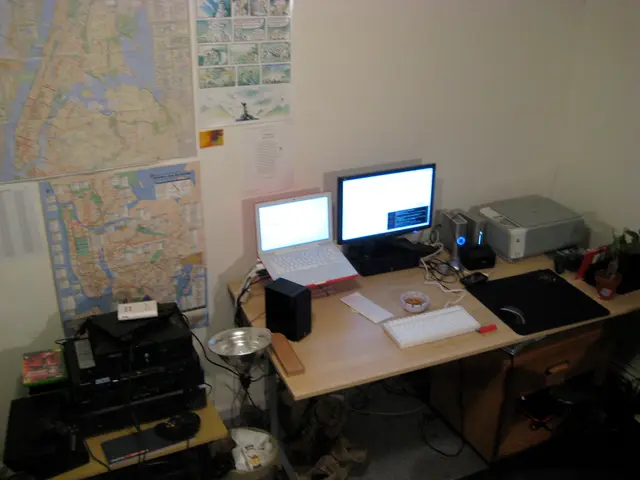AI Threatens Job Security for Many
In a rapidly evolving technological landscape, Artificial Intelligence (AI) is making significant strides, reshaping industries and demanding new skill sets. Here's a breakdown of current trends, the impact on human workers, and future implications, organised by key themes.
**Current Trends in AI Adoption**
Industries across the board are embracing AI, with a substantial majority of firms expected to adopt it by 2025. Notable sectors include healthcare, finance, education, manufacturing, and IT/telecom. AI integration in these industries is projected to yield substantial economic benefits, with the IT and telecom sector alone adding $4.7 trillion in gross value by 2035.
**Key Applications Driving Growth**
AI is making a significant impact in several sectors. In healthcare, AI models are outperforming human specialists in disease detection, leading to enhanced diagnostic accuracy and improved patient outcomes. In finance, AI streamlines risk assessment, fraud detection, and loan approvals, leading to increased efficiency and reduced losses. In education, adaptive learning platforms and AI tutors are personalising education, leading to better outcomes and reduced dropout rates.
**Impact on Human Workers**
The workforce is undergoing a transformation as AI automates routine tasks. Routine jobs such as clerical and secretarial roles, bank tellers, and payroll clerks are at risk of being replaced. However, demand is rising rapidly for AI and machine learning specialists, data analysts, and information security analysts.
The workforce is being reshaped to emphasise adaptability, continuous learning, and collaboration between humans and AI. Organisations are focusing on combining AI automation with human creativity and judgment, with routine tasks automated while complex problem-solving remains human-led.
**Future Implications**
As AI automates routine tasks, significant portions of the workforce will need to transition to new roles, with an emphasis on uniquely human skills such as creativity, empathy, and strategic thinking. The global AI market is growing at a CAGR of 35.9%, with 97 million people expected to work in the AI sector by 2025.
**Summary Table: AI Trends and Human Worker Implications**
| Industry | Main AI Trends | Impact on Human Workers | |------------------|---------------------------------|---------------------------------------| | Healthcare | Diagnostics, patient management | Enhanced accuracy, job evolution | | Finance | Risk, fraud, efficiency | Job displacement, new specialist roles| | Education | Adaptive learning, tutoring | Reduced dropout, new educator roles | | Manufacturing | Automation, predictive analytics| Job displacement, upskilling needed | | IT/Telecom | Network, security, CX | New technical roles, skill shifts |
AI is both a disruptive and enabling force. It is reshaping job markets, demanding new skill sets, and driving productivity and innovation across industries. Businesses and workers must adapt to thrive in this rapidly evolving landscape.
AI-powered robots are taking on tasks currently conducted by scientists, such as research and development, data analysis, and lab automation. AI-enabled trucks are being developed for more efficient, reliable, and cost-effective transportation. Cities are already using AI-enabled robots to improve operations and reduce costs in traffic management and public services.
Teachers are not being entirely replaced by AI, but robots can provide personalised, interactive learning experiences and give real-time feedback to teachers. AI-powered art generation tools can replicate realistic paintings, sculptures, and other works of art with a high degree of accuracy.
AI-enabled robots are being used in construction to reduce the risk of accidents on job sites and complete repetitive tasks more efficiently. Bookkeeping and data entry tasks are being automated, with machines capturing and storing information more accurately than humans.
In the pharmaceutical industry, AI is being used to analyse large amounts of data from clinical trials more quickly than human researchers can. Event planning software can automate several event planning tasks, such as analysing data on past attendee behaviour to optimise event scheduling and marketing.
The study by Michael Osborne and Carl Frey suggests that customer service executives, bookkeepers, data entry workers, receptionists, proofreaders, manufacturing workers, pharmaceutical drug designers, retail service workers, courier service workers, and soldiers are among the jobs that may be replaced by AI in the near future.
Security robots are being developed for private security departments to patrol locations and respond to threats. Autonomous vehicles are on their way to revolutionising the transport industry, with self-driving cars offering safer and more efficient transportation services.
AI can analyse vast amounts of data to create personalised marketing, content generation, and e-commerce strategies. AI-enabled robots can analyse complex data sets, such as structural loads, temperature analysis, and material stress patterns in architecture, creating precise designs that are more reliable and cost-effective than human architects.
The future battlefields and military operations are becoming automated, with highly autonomous robots and drones carrying out dangerous military operations like reconnaissance. AI is being used in the medical field to assist radiologists in making more accurate diagnoses and improving the quality of healthcare services.
In courier services, AI is being used to automate order processing and delivery statuses, improving customer experiences and speeding up the delivery process. The study by Michael Osborne and Carl Frey suggests that these advancements could lead to significant job displacement in the near future, emphasising the need for continuous learning and adaptation in the workforce.
- Reinforcement learning is used in robotics to automate tasks in various industries, such as research and development, data analysis, and lab automation, leading to increased efficiency and productivity.
- Natural language processing (NLP) plays a crucial role in autonomous vehicles, enabling self-driving cars to interact effectively with human drivers for safer and more reliable transportation.
- In finance, machine learning is streamlining risk assessment, fraud detection, and loan approvals, while AI is personalising education, leading to better outcomes and reduced dropout rates, thereby impacting lifestyle and education-and-self-development sectors.
- Technology companies are developing AI-enabled robots for construction to reduce risks and increase efficiency in repetitive tasks, while AI-powered art generation tools replicate realistic works of art, showcasing advancements in technology and lifestyle.
- Autonomous vehicles are expected to revolutionise the transport industry, offering safer and more efficient transportation services, however, the study by Michael Osborne and Carl Frey suggests that this progress could lead to significant job displacement, especially in courier services, emphasising the need for continuous learning and adaptation in the workforce.




